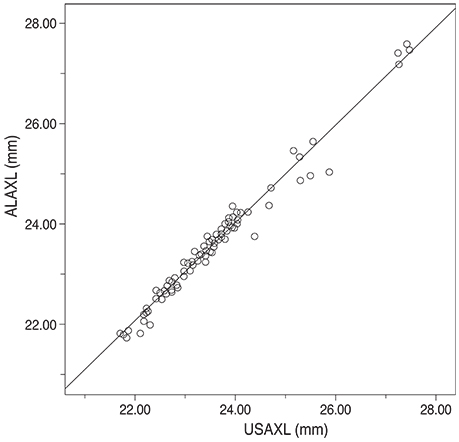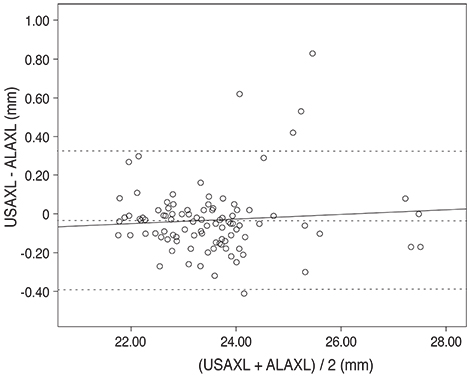Korean J Ophthalmol.
2014 Dec;28(6):444-450. 10.3341/kjo.2014.28.6.444.
Accuracy of Biometry for Intraocular Lens Implantation Using the New Partial Coherence Interferometer, AL-scan
- Affiliations
-
- 1Department of Ophthalmology, Busan Paik Hospital, Inje University College of Medicine, Busan, Korea.
- 2Therapeutics Center for Ocular Neovascular Disease, Busan, Korea.
- 3Shinsegae Eye Clinic, Busan, Korea. happytriad@gmail.com
- KMID: 2345820
- DOI: http://doi.org/10.3341/kjo.2014.28.6.444
Abstract
- PURPOSE
To compare the refractive results of cataract surgery measured by applanation ultrasound and the new partial coherence interferometer, AL-scan.
METHODS
Medical records of 76 patients and 104 eyes who underwent cataract surgery from January 2013 to June 2013 were retrospectively reviewed. Biometries were measured using ultrasound and AL-scan and intraocular lens power was calculated using the SRK-T formula. Automatic refraction examination was done 1 month after the operation, and differences between the ultrasound group and AL-scan group were compared and analyzed by mean absolute error.
RESULTS
Mean axial length measured preoperatively by the ultrasound method was 23.53 +/- 1.17 mm while the lengths measured using the AL-scan were 0.03 mm longer than that of the ultrasound group (23.56 +/- 1.15 mm). However, there was not a significant difference in this finding (p = 0.638). Mean absolute error was 0.34 +/- 0.27 diopters in the ultrasound group and 0.36 +/- 0.31 diopters in AL-scan group, which showed no significant difference (p = 0.946) in precision of predicting postoperative refraction.
CONCLUSIONS
Although the difference was not statistically significant, intraocular lens calculations done by the AL-scan were nearly similar in predicting postoperative refraction compared to those of applanation ultrasound, however more precise measurements may be obtained if the axial length is longer than 24.4 mm. Except in the case of opacity in the media, which makes obtaining measurements with the AL-scan difficult, AL-scan could be a useful biometry in cataract surgery.
MeSH Terms
-
Aged
Anterior Chamber/pathology
Axial Length, Eye/*pathology
Biometry/methods
Female
Humans
Interferometry/*instrumentation
*Lens Implantation, Intraocular
Lenses, Intraocular
Light
Male
Middle Aged
*Phacoemulsification
Refraction, Ocular/physiology
Reproducibility of Results
Retrospective Studies
Visual Acuity/physiology
Figure
Cited by 1 articles
-
Laser Iridotomy-Induced Bullous Keratopathy in Korea: Clinical Features and Comparison with Pseudophakic Bullous Keratopathy
Seung Yong Choi, Soon Il Choi, Sung A Lim, Man Soo Kim
J Korean Ophthalmol Soc. 2016;57(1):14-19. doi: 10.3341/jkos.2016.57.1.14.
Reference
-
1. Olsen T. Sources of error in intraocular lens power calculation. J Cataract Refract Surg. 1992; 18:125–129.2. Giers U, Epple C. Comparison of A-scan device accuracy. J Cataract Refract Surg. 1990; 16:235–242.3. Findl O, Drexler W, Menapace R, et al. Improved prediction of intraocular lens power using partial coherence interferometry. J Cataract Refract Surg. 2001; 27:861–867.4. Nemeth J, Fekete O, Pesztenlehrer N. Optical and ultrasound measurement of axial length and anterior chamber depth for intraocular lens power calculation. J Cataract Refract Surg. 2003; 29:85–88.5. Findl O, Drexler W, Menapace R, et al. High precision biometry of pseudophakic eyes using partial coherence interferometry. J Cataract Refract Surg. 1998; 24:1087–1093.6. Rajan MS, Keilhorn I, Bell JA. Partial coherence laser interferometry vs conventional ultrasound biometry in intraocular lens power calculations. Eye (Lond). 2002; 16:552–556.7. Cruysberg LP, Doors M, Verbakel F, et al. Evaluation of the Lenstar LS 900 non-contact biometer. Br J Ophthalmol. 2010; 94:106–110.8. Buckhurst PJ, Wolffsohn JS, Shah S, et al. A new optical low coherence reflectometry device for ocular biometry in cataract patients. Br J Ophthalmol. 2009; 93:949–953.9. Hasemeyer S, Hugger P, Jonas JB. Preoperative biometry of cataractous eyes using partial coherence laser interferometry. Graefes Arch Clin Exp Ophthalmol. 2003; 241:251–252.10. Lee MK, Hwang KY, Kim MS. Effects of axial length and vitrectomy on refractive error after cataract surgery using SRK/T formula. J Korean Ophthalmol Soc. 2013; 54:257–264.11. Drexler W, Findl O, Menapace R, et al. Partial coherence interferometry: a novel approach to biometry in cataract surgery. Am J Ophthalmol. 1998; 126:524–534.12. Haigis W, Lege B, Miller N, Schneider B. Comparison of immersion ultrasound biometry and partial coherence interferometry for intraocular lens calculation according to Haigis. Graefes Arch Clin Exp Ophthalmol. 2000; 238:765–773.13. Tehrani M, Krummenauer F, Blom E, Dick HB. Evaluation of the practicality of optical biometry and applanation ultrasound in 253 eyes. J Cataract Refract Surg. 2003; 29:741–746.14. Packer M, Fine IH, Hoffman RS, et al. Immersion A-scan compared with partial coherence interferometry: outcomes analysis. J Cataract Refract Surg. 2002; 28:239–242.15. Kiss B, Findl O, Menapace R, et al. Refractive outcome of cataract surgery using partial coherence interferometry and ultrasound biometry: clinical feasibility study of a commercial prototype II. J Cataract Refract Surg. 2002; 28:230–234.16. Song BY, Yang KJ, Yoon KC. Accuracy of partial coherence interferometry in intraocular lens power calculation. J Korean Ophthalmol Soc. 2005; 46:775–780.17. Madge SN, Khong CH, Lamont M, et al. Optimization of biometry for intraocular lens implantation using the Zeiss IOLMaster. Acta Ophthalmol Scand. 2005; 83:436–438.
- Full Text Links
- Actions
-
Cited
- CITED
-
- Close
- Share
- Similar articles
-
- Comparison of Preoperative and Postoperative Ocular Biometry in Eyes with Phakic Intraocular Lens Implantations
- Comparison of Ocular Biometry Measurements Using A-Scan Ultrasound and Two Types of Partial Coherence Interferometers
- Comparison of Biometric Measurements and Refractive Results between Applanation Ultrasonography and Three Different Interferometries
- Determine a Proper Axial Length by Ultrasonic Biometry in Opaque Hydrophilic Acrylic Intraocular Lens
- Comparison of Clinical Outcomes between Swept-source Optical Coherence Tomography Biometer and Partial Coherence Interferometer



